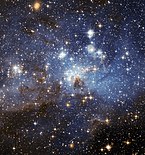User:OtterAM/sandbox

Triggered star formation occurs when the collapse of an interstellar molecular cloud to form new stars is instigated by external forces.
The process of how stars form is a topic of active research in astronomy.[1] A large fraction[a] of stars are born large star-formation complexes, which may birth tens to hundreds of thousands of young stars. Several examples of such complexes in our Milky Way Galaxy include the Orion Molecular Clouds (containing the Orion Nebula, the Flame Nebula, and the Horsehead Nebula) and the Carina Nebula (containing Trumpler 14, Trumpler 15, Trumpler 16, and the Treasure Chest. In these complex environments, interaction between young stars and the interstellar clouds of gas (molecular clouds) from which they form can significantly affect the star-birth process—a phenomenon known as feedback.
Triggering by Expanding H II Regions[edit]
| Star formation |
|---|
 |
| Object classes |
| Theoretical concepts |
Collect and Collapse Model[edit]
Radiation Driven Implosion Model[edit]
Examples[edit]

Triggering due to Galaxy Collisions[edit]
See also[edit]
References[edit]
- ^ a b Goddard Space Flight Center. "Cosmic Origins". Retrieved February 17, 2015.
- ^ Krumholz, M. R. (2014). "The Big Problems in Star Formation: the Star Formation Rate, Stellar Clustering, and the Initial Mass Function". Physics Reports. Bibcode:2014arXiv1402.0867K.
- ^ Getman, K. V. (2013). "My Favorite Object: The Elephant Trunk Nebula"" (PDF). The Star Formation Newsletter. 251: 6–11.
- ^ Dale, J. E.; et al. (2015). "The Dangers of Being Trigger-Happy". MNRAS. in press. Bibcode:2015arXiv150205865D.
{{cite journal}}: Explicit use of et al. in:|last2=(help) - ^ Shore, S. N. (1981). "The effects of induced star formation on the evolution of the Galaxy. I - One-zone models". Astrophysical Journal. 249: 93–98. Bibcode:1981ApJ...249...93S. doi:10.1086/159263.
- ^ Getman, K. V.; et al. (2012). "X-Ray Study of Triggered Star Formation and Protostars in IC 1396N". Astrophysical Journal. 654 (1): 316–337. Bibcode:2007ApJ...654..316G. doi:10.1086/509112.
{{cite journal}}: Explicit use of et al. in:|last2=(help) - ^ Getman, K. V.; et al. (2009). "Protoplanetary Disk Evolution Around the Triggered Star-Forming Region Cepheus B". Astrophysical Journal. 699 (2): 1454–1472. Bibcode:2009ApJ...699.1454G. doi:10.1088/0004-637X/699/2/1454.
{{cite journal}}: Explicit use of et al. in:|last2=(help) - ^ Getman, K. V.; et al. (2008). "The Stellar Population and Origin of the Mysterious High-Latitude Star-forming Cloud CG 12". Astrophysical Journal. 673 (1): 331–353. Bibcode:2008ApJ...673..331G. doi:10.1086/524004.
{{cite journal}}: Explicit use of et al. in:|last2=(help)
Notes[edit]
External links[edit]
Category:Star formation Category:Stellar astronomy
Combarbalite is a semiprecious variety of soap stone, produced by metamorphosis of volcanic material which occurred about 80 million years ago. The rock is found in abundance in the area of Combarbalá, a commune in the Limarí Province, Coquimbo Region, Chile, and has been collected by hand since prehistoric times.[1]
- ^ Anrique Vial, Macarena (March 19, 2010). "Lapislázuli y combarbalita: Materiales de una artesanía típica chilena". Retrieved April 6, 2011.

